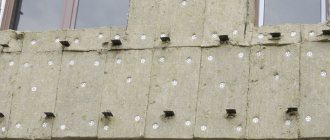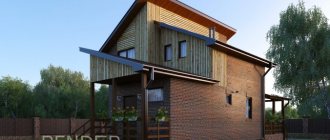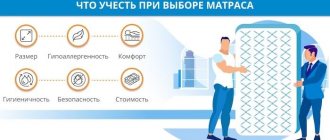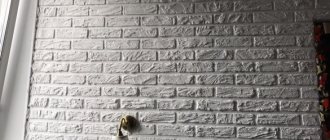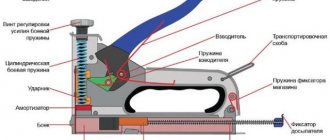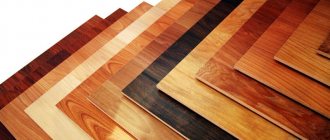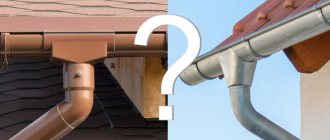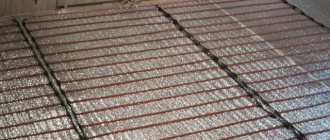In order for the conditions in the house to be at the highest level during the cold season, it is necessary not only to take care of the immediate heating system, but also to minimize the leakage of this heat through external structures. It is important to note that this includes not only walls, but also the ceiling and other similar elements.
As practice shows, a large amount of heat is lost due to overlap between floors. In this case, it is quite possible to easily solve this problem. All that is required is simply to use high quality material to insulate the heat. In this case, heat loss will be minimal, and this will significantly increase the efficiency of the heating system in the house. The optimal thickness of thermal insulation for the roof is necessary.
If an under-roof space is used in housing, the circuit in this room must be insulated. It is important to note that such insulation should be installed not only in the structure of the immediate roof, but also in the walls of a given room. In the same case, if the attic is non-residential, then the need for thermal insulation almost completely disappears. The role of additional insulation in this case is played by the volume of air. But in this case, it is necessary to select the optimal thickness of insulation for the roof.
How much material is needed for roof insulation?
To understand how much insulation is needed, you need to make preliminary calculations, focusing on the type of roof and its dimensions. It is important to remember that when installing thermal insulation from mineral wool, the material is laid out, that is, its width should be 1-2 centimeters larger than the gap between the rafters.
Roof insulation with mineral wool Source nkkrovlia.info
On a note! It is more logical to choose insulation at the stage of designing a house. Then you can immediately calculate the pitch of the rafter legs so that the insulation slabs fit perfectly between the boards, and you do not have to cut the slabs or connect several together.
The calculation allows you to determine how many slabs to place along and across the roof slope. To carry it out, the length of the slope and the distance between the rafters, as well as the number of rafter steps, are taken into account.
Roof thermal insulation rules
Thermal insulation is planned during the process of creating a house project. The material is selected according to the type of roof. They take into account whether the room in the attic space will be used. Regardless of the type of roof, it should consist of the following layers:
- roofing material;
- ventilation;
- wind and moisture protection;
- ventilation gaps;
- insulation;
- vapor barrier layer.
Violation of this system, as well as gross installation errors, lead to roof defects. And in some cases - to its complete destruction.
Some types of roofs, for example, flat ones, are not as demanding in terms of wind protection as roofs with a slope of 10 degrees or more.
When arranging an attic or residential attic, a layer of thermal insulation and vapor barrier must be covered with natural wooden boards. They will protect materials and improve the appearance of the room.
Calculation example
Let's calculate how much mineral wool is needed for a gable symmetrical roof with seven rafter intervals 60 cm wide and a slope length of 5 m. at the same time, the dimensions of the slab are 1.17x61x25cm.
First, we determine the number of slabs in one row: 5/1.17 = 4.27 pcs.
We multiply the result by the number of steps (7): 4.27x7 = 29.89 slabs will be needed for one slope and 59.78 for the entire roof. It is better to round the resulting result up, that is, 30 and 60 pieces, respectively.
Mineral wool Source haikudeck.com
Styrofoam
It has a cheap price, and therefore is perceived by many as the best solution. But at the same time, everyone points to the shortest service life - the material decomposes, breaks.... Based on this factor alone, it already inspires serious concern in structures behind the skin, where it is difficult to check its condition.
There is also some difficulty in placing between the rafters, since the foam sheets are not as elastic as mineral wool. Precise adjustment with a float is required, leaving gaps that need to be foamed...
There has been some progress in sound insulation compared to polyurethane foam, since it is possible to cover the rafters with a layer in the counter-lattice.
But the downside is fire safety - it requires a continuous fireproof fence from the living space. Mice and birds love this material and love to breed in it. They destroy it with pleasure. Therefore, the structure must be securely closed, which is difficult to do...
Which insulation is better
When determining the most affordable material, you need to take into account the cost of installation and transportation. At a lower price, insulation can cost a pretty penny due to transport costs and additional installation costs.
Expanded polystyrene
Extruded polystyrene has excellent thermal conductivity, which makes it possible to apply a thin layer of insulation to the roof. Its light weight, ease of fixing to the surface and cost-effectiveness make the material highly popular. Despite the price.
Expanded polystyrene Source dmcp.ru
See also: Catalog of companies that specialize in roofing materials.
Mineral wool
Mineral wool, as this insulation is called for short, is a material made from mineral fibers. Mineral wool is laid in slabs, which need to be additionally secured. The main advantage is the ability to withstand high temperatures. This is an ideal material for insulating the roof of a bathhouse.
Polyurethane foam
Polyurethane foam is thermal insulation applied by spraying. It can be soft or hard. Soft is used for internal thermal insulation, and hard - only for external insulation. This type of insulation should only be applied by professionals. An ideal option for roofs of complex structures, it has economical consumption.
Review of manufacturers
There are hundreds of brands on the market that produce decent products. Leading brands include:
- Rockwool . Danish brand, but factories are located in other countries, including Russia. Regional production ensures low prices for products with high performance characteristics. Specializes in mineral and basalt wool.
- Knauf . The German company offers excellent thermal insulation, but the price is high. Environmentally friendly mineral wool from the brand will last from 15 to 50 years.
- Isover . The brand produces mineral, basalt and glass wool in various forms.
- "TechnoNIKOL" . Russian company specializing in the production of high-density slab wool.
- "Ursa" . The company produces high-strength and durable roll insulation with acrylic, which prevents fiber fragility.
- Hotrock . The company produces non-flammable slab basalt insulation, easy to use.
- "Penoplex" . Produces polymer sheet insulation.
What determines the thickness of the insulation?
Since all insulation materials have their own characteristics, the choice of material is related not only to its qualities and price, but also to the characteristics of the roof.
A parameter such as roof thickness is determined already at the design stage. In this case, we focus on the following parameters:
- thermal conductivity of the material : the less thermally conductive the material, the thinner the coating can be, and vice versa;
- climatic conditions in the area where the house will be built.
The more humid and cold the climate, the thicker the insulation layer will be Source centro-stroi.ru
Glass wool
This well-proven thermal insulator has technical characteristics similar to mineral wool. In the production of glass wool, glass melt is used.
It is sold on the construction market in rolls and in the form of slabs. This is an environmentally friendly insulation material with good soundproofing qualities. When installing a heat-insulating layer using glass wool, roofers use protective clothing and special equipment and follow safety precautions so as not to cause harm to health.
Before insulating the roof of a private house using mineral wool, you need to select a vapor barrier material, and at the same time, glass wool slabs may already have a foil coating on the outside - its presence simplifies the installation of the thermal insulation layer.
How to calculate the thickness depending on the selected insulation
When calculating the thickness of the roof, they are based on the climatic characteristics of a particular region, as well as the thermal conductivity parameters of the insulating material. The correct choice of insulating material minimizes heating costs, helps create comfortable conditions in the house that meet sanitary standards, and also extends the service life of the structural elements of the building itself.
The requirements for thermal protection of houses are described in SNiP 02/23/2003 (“Thermal protection of buildings”) Source orchardo.ru
The calculation is made using the following formula:
α ut =(R 0 in -0.16) λ ut
- α ut is the thickness of the insulation in meters;
- R 0 prev . – reduced heat transfer resistance of the coating, m2 ° C/W, in other words, the ability of the material to resist the flow of heat rising with the air to the roof and going out;
- λ ut – thermal conductivity coefficient of insulation, W/(m °C).
Depending on the operating conditions, marked in the table below with the letters A and B, λ A or λ B .
Heat transfer resistance in different climatic zones of the Russian Federation Source keywordbasket.com
* depending on conditions, λ а =0.04 ; λ b =0.042
That is, the thickness of the insulation for a building located in Tver will be equal to:
α ut =(4.70-0.16)·0.042= 0.19m
The thickness of the insulation directly depends on the climate zone in which the house is located. The colder the winter and the longer the heating season, the thicker the insulation layer will be. If in the capital the resistance to heat transfer of the external walls of a building is normally 3.28, then in cold Yakutsk it is already required to be 5.28.
In addition to climate, the thermal resistance of a wall is also affected by the material from which it is made, as well as its thickness. Walls made of brick or concrete will require a thicker layer of insulation than wood or foam block, since the thermal conductivity of the latter is much lower.
The thickness of the insulation directly depends on the climate zone Source et.aviarydecor.com
7Foam plastic
Polystyrene foam is considered a universal insulation material, which is used at different stages of house construction. It should be noted that there are many brands that differ in density and grain size.
Thus, white polystyrene foam PSB-15 is not suitable for laying on floors due to its low strength. The exception is installation between joists. But filling the space in the roofing pie is very convenient. Foam plastic attracts attention primarily due to its low price and light weight.
The material is easily cut with a regular knife, and there are no problems with installation. Many users consciously purchase the cheapest heat insulator, understanding all its shortcomings. The material crumbles, breaks, and decomposes. It cannot be precisely adjusted to each other, so the resulting gaps have to be foamed. To ensure the fire safety of a living space, it is necessary to install a fireproof fence.
Foam glass was invented a long time ago, but thanks to modern technologies it has been possible to achieve unique properties. The innovation of the material lies in the honeycomb-like structure of foamed silicate glass. The scope of application of the insulation is quite wide. When constructing a roof, slabs are usually used.
Experts note a number of positive properties of insulation. It is safe for humans, since foam glass is made from environmentally friendly raw materials. The service life reaches 100 years, the material is not affected by microorganisms, and is not destroyed by birds, rodents or insects.
It is not afraid of climatic influences, the insulation does not deform under high loads. And you can cut the slabs with a regular hacksaw. As for the disadvantages, the main one will be the high price. Thermal insulation does not conduct steam, the material itself is quite heavy, and damaged areas cannot be repaired.
Ecowool is of great interest to consumers today. First of all, the insulation attracts attention due to its environmental friendliness.
The main components of the heat insulator are paper and cardboard products. For the production of ecowool, defective paper, cardboard waste, and newspaper-type waste paper are used. Antifungal and fireproof additives are also introduced into the composition, their volume reaches 20%. In addition to being environmentally friendly, cellulose-based insulation has a high sound insulation rate.
During the application process, it is possible to fill all hard-to-reach places, forming continuous thermal insulation. Ecowool has its own characteristics, which are important to consider when installing a roof. Over time, the material decreases in volume, which causes an increase in thermal conductivity. Experts recommend adding 20-25% more insulation. To prevent ecowool from absorbing moisture, you need to take care of effective ventilation.
One of the most effective roof insulation materials is polyurethane foam.
A special feature of this material is the need to spray it. The product is supplied in the form of two liquids, which are mixed before application. Working with polyurethane foam requires special equipment and protective clothing. After hardening, a continuous seam is formed, and the degree of thermal insulation can be adjusted by the thickness of the layer.
Since polyurethane foam does not allow steam to pass through, it is first necessary to make a lathing. Polyurethane foam is a synthetic material, so it is not damaged by rodents and insects. Experts attribute the high cost of the coating to the disadvantages of insulation. In addition, the service life of polyurethane foam is shorter than that of other roofing materials. The soundproofing properties are not the best, so when installing the roof you will have to install an additional layer of sound absorber.
To insulate attic floors, loose expanded clay insulator is often used. It consists of pebbles of a certain size with many pores inside.
Expanded clay is used to fill the space between the joists, forming a continuous sound and heat insulating layer. The high popularity of expanded clay is explained by its affordable price and durability. This material is not afraid of moisture, it is not affected by mold or mildew, and it does not make mouse nests. And the frost resistance of expanded clay allows it to be used in extreme climates.
Since the insulation is made of clay, experts call environmental friendliness one of the advantages. The disadvantages include the fragility of the granules; even when falling asleep, care must be taken. When expanded clay is damaged, its thermal conductivity deteriorates. And the scope of application of this insulation is limited to the floors of the house.
Mineral wool has good heat and sound insulation properties. Ease of installation is combined with an affordable price, which makes the material one of the most popular when performing roofing work.
The undoubted advantages of mineral wool include fire safety and biostability. The material has been used in construction for a long time, but if previously it was a fiberglass base, now environmentally friendly materials (basalt) are used. When installing a pitched roof, the slabs are inserted between the rafters, and the material can also be laid between the joists. For a flat roof, a more rigid mineral wool is used, the density of which reaches 140-160 kg/cu.
m. The heat insulator also has some disadvantages that are important to consider when installing the roof. When wet, thermal conductivity doubles, so it is necessary to eliminate any leaks. Over time, the insulation may crumble.
The economic feasibility of use often justifies the choice of insulation such as foil-coated polystyrene foam. With its help, you can not only retain heat in the attic, but also provide a reliable barrier to moisture.
The basis of the insulation is extruded polystyrene, which resembles foam rubber in structure. The foil layer reflects up to 97% of thermal radiation, which makes the heat insulator one of the most effective. In addition, the material provides 100% waterproofing when installed correctly. Selecting the most suitable panel is not difficult; their thickness ranges from 10 to 100 mm.
It is convenient to lay the insulation; it is light in weight, easy to cut, and easy to install. A thin layer does not always provide the necessary thermal insulation; it is often necessary to install another layer of insulation. Over time, the foil begins to oxidize, which leads to clouding and deterioration of reflective properties. Attention! The information presented above is not a guide to purchase. For any advice, you should contact specialists! The cheapest insulation is not always of poor quality. Energy resources are constantly becoming more expensive and, in connection with this, the issue of thermal insulation of house walls has become more pressing than ever. Before you start selecting materials for thermal insulation, you need to find out how much moisture they allow through.
If the insulation does not allow moisture to pass through, it will accumulate on the walls and soon mold or mildew will appear on your walls. If the insulation has good moisture permeability, this does not mean that it can be used only for interior decoration; it can also be used for exterior wall decoration. Contents: Insulation has a large number of choices and consists of different materials. The cost of insulation is also different, it depends on functionality. Now let’s look at 4 types of popular insulation and compare their costs: Mineral wool is made from fiberglass, it can be used to insulate walls, roofs, and pipes.
Floors and flat roofs. This insulation has good insulating properties, but when heated, it releases a chemical that can cause illness in your body's respiratory system. The cost of such insulation is from 1500 rubles. per cubic meter. Insulation made of basalt wool. It is non-flammable and has increased safety and density.
Its use is optimal for roof insulation. The cost of such insulation is from 1500 rubles. and up to 3500 rub.
per cubic meter. Liquid foam insulation is considered to be the most budget-friendly insulation, its cost starts from 1400 rubles. per 1 cubic meter. But its use is limited. It can be used for sealing small areas, such as gaps, cracks, but not for insulating walls and floors. An insulation convenient for doing the work yourself is polystyrene foam.
It is lightweight and convenient to use, and performs excellent protective functions against the cold. It can be used to insulate walls not only on the street side, but also indoors, but in the event of a fire it emits acrid smoke. The cost of such insulation is from 1500 rubles. per cubic meter. Mineral wool has good insulating properties. Among different types of insulation, polystyrene foam and polystyrene are popular.
It is important to remember that polystyrene foam is the most budget-friendly option for insulation and does not require finishing. After finishing walls or other insulation, polystyrene foam is reinforced with a special mesh and puttied or plastered; the plaster must be based on a special glue. Next, the insulation can be decorated using a variety of building materials. The best decoration option would be painting or decorative plaster.
How is the thickness for attic insulation determined?
Attics of houses can be residential or non-residential. If in cold attics only the ceiling itself is insulated, which separates the ceiling of the house from the attic room, then in residential attics the slopes and side walls, if any, are also sheathed with insulation. In total, mansard roofs have three types of enclosing structures:
- attic ceiling;
- stingrays;
- gable walls.
On a note! The main distinctive feature of attic insulation work is that different building envelopes require different thicknesses of insulation. If a more dense layer is required for the roof, then the walls have less thermal conductivity, which means the insulation will be thinner. Calculations for each type of fencing are made separately.
Wood sawdust
Long before the advent of modern thermal insulation materials, sawdust, a wood waste product, was especially popular when it was necessary to insulate the roof of your own home. They are environmentally friendly, hypoallergenic, but flammable, which must be taken into account when choosing an insulation option. In addition, rodents love to live in them, and sawdust is also susceptible to rotting.
This bulk material does not insulate the roof structure, but only the ceiling. Ecowool can be used similarly. By laying sawdust in an even layer, the ceilings of residential premises in their own homes are effectively insulated.
In order to enhance the thermal insulation properties, sawdust is mixed with clay and the attic floor is treated. Their use is possible only on the condition that the attic space will not be used.
The correct choice of insulation and high-quality arrangement of the roofing pie allows you to provide a microclimate favorable for its residents in a private household throughout the year, and save on heating in winter.
Ceiling insulation with a cold roof
If the attic is not used during the cold season, then only the attic floor is insulated, leaving the roof without insulation.
If there is no living room in the attic, then thermal insulation of the ceiling will allow heating only those rooms that are used Source chudopol.ru
When insulating an attic floor, a layer of insulation is placed on top of the floor itself and covers, among other things, the ends of the walls. If you place the insulation layer inside, the ceiling walls will still radiate heat outside.
This method of insulation significantly simplifies installation work. After all, laying it on a flat surface under the roof is easier than securing the material to the slopes.
Polyurethane foam
Effective insulation with the lowest thermal conductivity coefficient of 0.03 W/mC is also attractive because it is sprayed and creates a continuous cover without seams. Polyurethane foam has low vapor permeability and water absorption.
But this material, from the point of view of finding the best insulation for the roof, has such disadvantages.
The high price of the finished coating – from 1200 rubles/sq.m.
with a layer thickness of 10 cm. The predicted service life is shorter than that of the main structures of the house. The consequences of the effect of vapor barrier on wood are questionable, under conditions when the rafter will be enveloped in this material up to 80% of the surface area. In panel structures, polyurethane foam can be a filling material for structures strength that holds the plywood together. But such houses are cheap and not durable. Poor sound insulation qualities require the lowest noise roofing. Moreover, the rafters remain sound bridges in the design, which requires the introduction of another continuous layer of sound absorber under the inner lining for satisfactory comfort.
All this together limits the popularity of polyurethane foam.
Construction calculator for calculating the amount of consumables
Many construction-related websites contain construction calculators, the main task of which is to help the future homeowner make approximate calculations related to the purchase of materials, understand the scale of the upcoming work and the cost of everything necessary.
Although building a house is a complex process with many nuances, the final cost largely depends on the materials used and their quantity. This means that even a simple online calculator will help you figure out the approximate cost of construction and figure out which material is more profitable to use.
Calculation of materials Source dcgate.pp.ua
In their calculations, calculators use several calculation options:
- Based on the total area of the building . The user specifies the linear dimensions of the house, the number of floors and the material used for the walls. The calculator determines the approximate cost. This type of calculation has a large error.
- Based on the type of project . The calculation is carried out in several steps based on architectural, as well as structural and engineering designs. The cost of building each “box”, the cost of finishing and communications are calculated separately. The more templates the calculator uses, the more accurate the calculation will be.
- Foundation calculators determine the amount of concrete, formwork material and reinforcement for constructing the foundation of a house with given parameters.
The accuracy of the result is also affected by the number of templates Source stroimdom.com.ua
- The universal calculator takes into account the type of floor, material of manufacture and other nuances in the calculation.
Some calculators give the total cost of the house, others - a specific part of the work. Depending on his needs, the site visitor himself chooses a convenient option.
How to insulate a flat roof of a house with your own hands
Insulating flat roofs on your own is possible for everyone. If you delve into the matter well, prepare properly and follow all the instructions step by step, then you can do this work almost at a professional level.
Insulating a flat roof from the outside
To insulate the roof with your own hands, use any of the classic installation methods described above. A feature of insulation can only be the type of insulated roof base (reinforced concrete or corrugated steel sheet) and the technique for attaching the heat-insulating layer.
Methods for attaching thermal insulation board:
- mechanical method;
- ballast method;
- glue method.
Mechanics. Thermal insulation boards are fixed mechanically using special sliding fasteners. They are long, complex anchor designs, with self-tapping screws screwed into the base. The telescopic mount goes through the entire thickness of the construction pie, and the plastic flat heads rigidly hold the entire structure. For reinforced concrete slabs, special anchors are used, and for cement screeds, plastic sleeves are used.
Ballast. Thermal insulation boards are laid on a flat roof and covered with a layer of waterproofing, and then, on top of it, a layer of gravel (expanded clay) is poured. If the roof is operational, then instead of a loose layer after waterproofing, plastic supports are installed on the roof surface for laying tiles. All elements of the roofing pie lie absolutely free (ballast). Fastening is carried out only around the perimeter of the roof, at the exit points of the chimney, ventilation and drainage system.
Glue. Heated bitumen mastic is used as glue in this method of roof insulation. Thermal insulation slabs are glued to the base (reinforced concrete panel). It is necessary that the adhesive adhesion of both surfaces be at least 30% of the entire roof area. All other layers of the roofing pie are attached in the same way. It should be remembered that all work must be carried out on a dry day, otherwise the insulation will absorb moisture and lose all its useful qualities.
Insulating a flat roof from the inside
Physically insulating the roof from inside the house is not very convenient, since most of the work requires holding your hands up. However, this process also has its advantages - insulation is carried out regardless of weather conditions, and there is no risk of the thermal insulation material getting wet.
The classic method of insulating a roof from the inside of a house is done in the following order:
- A lath is made from timber on the ceiling. The dimensions of the wooden beam must match the thickness of the insulation board, and the width of the step between the beams must match its width. The insulation board is easy to cut; if necessary, it can be cut to any size.
- Next, insulation boards (mineral wool or expanded polystyrene) are attached to the finished sheathing. For this purpose, glue, bitumen mastic, and a stapler are used.
- After all the intermediate areas between the lathing slats are filled with insulation, proceed to the stage of waterproofing the ceiling. A vapor barrier film is secured to the sheathing bars using a construction stapler.
- Then the ceiling is covered with plasterboard, a suspended ceiling is made, or one is combined with the other. Further finishing of the ceiling is carried out according to our own design.
By following the rules for insulating the roof from the inside, you can be absolutely sure that the house will be warm, dry and comfortable. A roof made with your own hands “conscientiously” will become a reliable outpost and a source of special pride for the owner.
Video description
Should you trust online calculators, watch the video:
The calculator helps estimate the cost of work Source www.strojmag.ua
Using the calculator, you can calculate the number of bricks for masonry, the cost of finishing, the dependence of insulation consumption on the width of the material, and many other parameters.
It is important to remember that the calculator does not provide exact numbers that can be used when designing or purchasing materials. It only helps to understand the principle of calculations and determine how much the same work will cost using different materials or projects. Full construction calculations can only be performed by qualified specialists.
Ecowool
To make insulation such as ecowool, waste paper is used. This heat insulator is environmentally friendly with excellent sound and heat insulating properties. But, as you know, cellulose is a flammable material and can be damaged by rodents and microorganisms. For this reason, ecowool is treated with bioprotective compounds and fire retardants.
This material is lightweight and inexpensive. But the installation of roof thermal insulation requires a special approach when it is necessary to install ecowool between the rafters. Closed “boxes” are made from tiled materials, then insulation is blown into them, completely filling the cracks with it.
Among the disadvantages of the heat insulator, it should be noted that it is necessary to prepare for installation and use special equipment.
conclusions
So, what is the best roof insulation? You can choose the option like most and use mineral wool
If we are talking about insulating the roof floor, pay attention to ecowool. When calculated, its cost is not that high
But this is an environmentally friendly material that is not afraid of rodents. And this is a big plus. We have given enough general insights that will help you choose insulation
However, no matter how correctly the chosen material is selected, when laying the insulator it is important to adhere to the installation rules, which we described separately
As we found out, roof insulation can be not only buns with hot chocolate, but also at least 6 other good materials. Choose and let your roof be as warm as Carlson’s.
